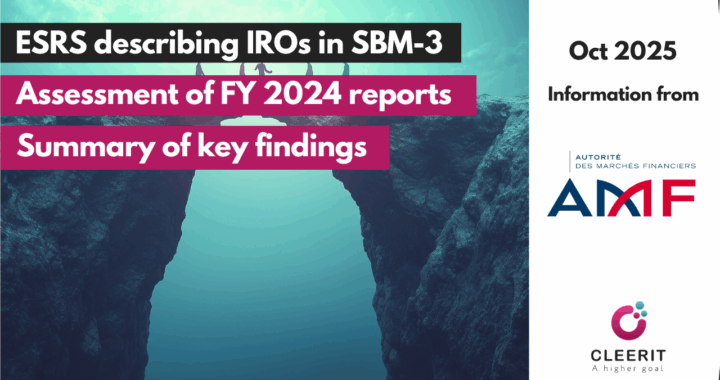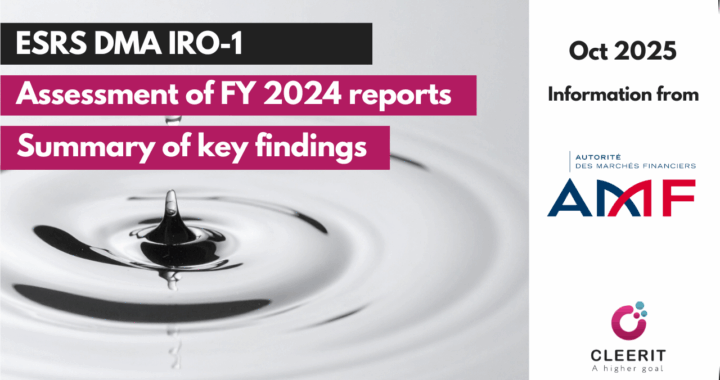AMF, the French Financial Markets Authority assessed a sample of ESRS statements published by French listed companies under the CSRD for financial year 2024.
This report is very valuable as it gives you information on what the financial marketplace is expecting from your sustainability reports.
We will send you the information regrouped by subject.
Below you will a summary of the key findings related to the Double Materiality Assessment outcome and description of IROs (ESRS 2 SBM-3).
Reporting on materiality assessment outcomes (SBM-3)
There is an increased comparability with a widespread use of the ESRS 1 AR16 list of topics and sub-topics (standardized terminology), even if the mapping with these ESRS topics is sometimes unclear
The format, granularity and location of these disclosures are very heterogeneous.
Several companies present both a brief overview of the material IROs in the general section and a more detailed description of IROs in the topical sections, which seems to be a balanced approach to avoid duplications and increase overall readability of the report.
Many companies present the results of the DMA in tables or with narrative information.
Only a few companies presented a matrix that maps IROs on financial and impact materiality axes (in addition to other narrative information).
One common evolution is the replacement of the “stakeholders’ view” axis by the broader “impact materiality” axis.
As a good practice, a few companies provide a comparison of the DMA results with previous reporting periods (with more or less details on the changes). Others explain that the results were not comparable because of changes in methodology.
Examples of common shortcomings:
- While most companies report on all their material topics, a few companies only report on most material/critical topics (which is not in line with ESRS requirements).
- The nature of IRO is unclear (e.g. to distinguish risk vs impact or « positive » vs. « negative ») or the description of the IRO is missing or boilerplate (e.g. for impacts, not possible to understand the effect on people or the environment, as required by SBM-3).
- Missing information on associated time horizons or location in the value chain. Few companies explain difficulties to evaluate IROs on different time horizons.
- Unclear mapping between material IROs and sustainability topics (listed in ESRS 1 AR 16) and unclear identification of entity-specific subtopics.
- Mitigation of a negative impact is sometimes presented as a positive impact (or a potential sustainability risk is presented as an opportunity).
- Inconsistencies in the list of material IROs presented in different parts of the statement.
- Presentation of materiality matrix with no precise axes (line drawn for materiality threshold with no figure/explanation on the construction of the graph).
Distinction of gross vs. net IROs and their description
Not all companies clearly distinguish between gross and net IROs when presenting the result of the DMA (if prevention and mitigation actions were taken into consideration or not), although several companies explain that the aim of the DMA process is to identify gross IROs.
We sometimes noted some confusion: some companies present their mitigation efforts (net IROs) within their IRO-1 sections, which should be focused on gross IROs in line with the ESRS.
A good practice identified was that several companies establish a link between the DMA results and risk factors identified in the management report.
Most refer to the sustainability statement in the risk factors section. However, the difference with the ESRS approach is not explained.
Some companies make the connection within the sustainability statement itself and explain the differences with risk factors (ESRS based on gross assessment, vs. risk factors based on net risks assessment).
Current financial effects (SBM-3, 48d)
Many companies do not disclose information on current financial effects required by SBM-3.
For other companies, the methodology used is often not presented (for example: how net effects are assessed).
Some companies explain that they do not have current financial effects, without explaining the methodology.
Some companies provide generic narrative disclosures (only describing the nature of the risk or very brief explanation on both financial effects and impacts on people of an IRO in the same paragraph).
Few provide more specific information by referring to the current financial effects presented in the notes in the financial statement.
Anticipated financial effects (SBM-3, 48e)
Most companies do not disclose this information, and some companies explicitly state that they are relying on the phase-in option.
Among the few companies that report that they have assessed anticipated financial effects, only one provides quantitative estimates on a voluntary basis but restricted to short term horizons.
There is not always a clear distinction between current and anticipated financial effects in the disclosures.
Source: https://www.amf-france.org/sites/institutionnel/files/private/2025-10/amf_study_csrd_reporting_the_way_forward_2025.pdf
When you use Cleerit ESG to structure and document your IROs and double materiality assessment you increase both ESRS compliance and make CSRD useful for your business as it will help you identifying issues material for your resilience and competitiveness. Contact us if you want to know more >>>

